Deck 13: The Solid State
Question
Question
Question
Question
Question
Question
Question
Question
Question
Question
Question
Question
Question
Question
Question
Question
Question
Question
Question
Question
Question
Question
Question
Question
Question
Question
Question
Question
Question
Question
Question
Question
Question
Question
Question
Question
Question
Question
Question
Question
Question
Question
Question
Question
Question
Question
Question
Question
Question
Question
Question
Question
Question
Question
Question
Question
Question
Question
Question
Question
Question
Question
Question
Question
Question
Question
Question

Unlock Deck
Sign up to unlock the cards in this deck!
Unlock Deck
Unlock Deck
1/67
Play
Full screen (f)
Deck 13: The Solid State
1
Copper crystallizes in a face-centered cubic lattice. The radius of a copper atom is 128 pm. What is the edge length of the unit cell?
A) 362 pm
B) 256 pm
C) 512 pm
D) 272 pm
E) 128 pm
A) 362 pm
B) 256 pm
C) 512 pm
D) 272 pm
E) 128 pm
362 pm
2
Which one of the following statements is incorrect?
A) Polonium is the only metal that has a primitive cubic lattice.
B) The lattice structure of the alkali metals is body-centered cubic.
C) Many metals can crystallize in more than one type of crystal lattice.
D) Metals with a body-centered cubic lattice contain a net of four metal atoms per unit cell.
E) A hexagonal close packed structure is not an example of a cubic unit cell.
A) Polonium is the only metal that has a primitive cubic lattice.
B) The lattice structure of the alkali metals is body-centered cubic.
C) Many metals can crystallize in more than one type of crystal lattice.
D) Metals with a body-centered cubic lattice contain a net of four metal atoms per unit cell.
E) A hexagonal close packed structure is not an example of a cubic unit cell.
Metals with a body-centered cubic lattice contain a net of four metal atoms per unit cell.
3
The metal vanadium crystallizes in a body-centered cubic lattice. If the density of vanadium is 6.11 g/cm3, what is the atomic radius of vanadium?
A) 25.3 pm
B) 104 pm
C) 35.3 pm
D) 31.9 pm
E) 131 pm
A) 25.3 pm
B) 104 pm
C) 35.3 pm
D) 31.9 pm
E) 131 pm
131 pm
4
Which equation represents the number of atoms in a body-centered cubic unit cell?
A)
B)
C)
D)
E)
A)
B)
C)
D)
E)

Unlock Deck
Unlock for access to all 67 flashcards in this deck.
Unlock Deck
k this deck
5
What is the distance, in atomic radii, along any edge of a body-centered cubic unit cell?
A)
B) 2 × r
C) 4 × r
D)
E) r
A)
B) 2 × r
C) 4 × r
D)
E) r

Unlock Deck
Unlock for access to all 67 flashcards in this deck.
Unlock Deck
k this deck
6
A metal crystallizes in a face-centered cubic lattice. The atomic radius of the metal is 198 pm and the density of the metal is 6.57 g/cm3. What is the volume of the unit cell?
A) 3.25 × 107 pm3
B) 1.52 × 109 pm3
C) 1.76 × 108 pm3
D) 7.76 × 106 pm3
E) 1.3 × 108 pm3
A) 3.25 × 107 pm3
B) 1.52 × 109 pm3
C) 1.76 × 108 pm3
D) 7.76 × 106 pm3
E) 1.3 × 108 pm3

Unlock Deck
Unlock for access to all 67 flashcards in this deck.
Unlock Deck
k this deck
7
The metal vanadium crystallizes in a body-centered cubic lattice. If the density of vanadium is 6.11 g/cm3, what is the unit cell volume?
A) 5.44 × 105 pm3
B) 1.99 × 105 pm3
C) 2.77 × 107 pm3
D) 1.38 × 107 pm3
E) 3.98 × 105 pm3
A) 5.44 × 105 pm3
B) 1.99 × 105 pm3
C) 2.77 × 107 pm3
D) 1.38 × 107 pm3
E) 3.98 × 105 pm3

Unlock Deck
Unlock for access to all 67 flashcards in this deck.
Unlock Deck
k this deck
8
Arrange the three common cubic unit cells in order from least dense to most dense packing.
A) Face-centered cubic < body-centered cubic < primitive cubic
B) Primitive cubic < body-centered cubic < face-centered cubic
C) Primitive cubic < face-centered cubic < body-centered cubic
D) Body-centered cubic < primitive cubic < face-centered cubic
E) Body-centered cubic < face-centered cubic < primitive cubic
A) Face-centered cubic < body-centered cubic < primitive cubic
B) Primitive cubic < body-centered cubic < face-centered cubic
C) Primitive cubic < face-centered cubic < body-centered cubic
D) Body-centered cubic < primitive cubic < face-centered cubic
E) Body-centered cubic < face-centered cubic < primitive cubic

Unlock Deck
Unlock for access to all 67 flashcards in this deck.
Unlock Deck
k this deck
9
Palladium crystallizes in a face-centered cubic lattice with an edge length of 388.8 pm. What is the density of palladium?
A) 0.752 g/cm3
B) 3.01 g/cm3
C) 1.50 g/cm3
D) 6.01 g/cm3
E) 12.0 g/cm3
A) 0.752 g/cm3
B) 3.01 g/cm3
C) 1.50 g/cm3
D) 6.01 g/cm3
E) 12.0 g/cm3

Unlock Deck
Unlock for access to all 67 flashcards in this deck.
Unlock Deck
k this deck
10
For a metal that crystallizes in a body-centered cubic unit cell, what percentage of the space in the cell is occupied by the metal atoms?
A) 47%
B) 62.4%
C) 68%
D) 77%
E) 87%
A) 47%
B) 62.4%
C) 68%
D) 77%
E) 87%

Unlock Deck
Unlock for access to all 67 flashcards in this deck.
Unlock Deck
k this deck
11
Iron crystallizes in a body-centered cubic lattice. If the radius of iron is 126 pm, what is the unit cell edge length?
A) 291 pm
B) 252 pm
C) 168 pm
D) 126 pm
E) 54.6 pm
A) 291 pm
B) 252 pm
C) 168 pm
D) 126 pm
E) 54.6 pm

Unlock Deck
Unlock for access to all 67 flashcards in this deck.
Unlock Deck
k this deck
12
Palladium crystallizes in a face-centered cubic unit cell. If the edge length of the unit cell is 387 pm, what is the radius of a palladium atom in picometers?
A) 137 pm
B) 548 pm
C) 1100 pm
D) 316 pm
E) 48.4 pm
A) 137 pm
B) 548 pm
C) 1100 pm
D) 316 pm
E) 48.4 pm

Unlock Deck
Unlock for access to all 67 flashcards in this deck.
Unlock Deck
k this deck
13
What is the length of the diagonal (in atomic radii) along the face of a face-centered cubic unit cell?
A)
B) 2 × r
C) 4 × r
D)
E) r
A)
B) 2 × r
C) 4 × r
D)
E) r

Unlock Deck
Unlock for access to all 67 flashcards in this deck.
Unlock Deck
k this deck
14
Cesium crystallizes in the body-centered cubic system. If the edge of the unit cell is 612 pm, what is the radius of a cesium atom in picometers?
A) 265 pm
B) 1060 pm
C) 1410 pm
D) 1220 pm
E) 115 pm
A) 265 pm
B) 1060 pm
C) 1410 pm
D) 1220 pm
E) 115 pm

Unlock Deck
Unlock for access to all 67 flashcards in this deck.
Unlock Deck
k this deck
15
If a metal crystallizes in a body-centered cubic lattice, each metal atom has _____ "nearest neighbors."
A) 3
B) 4
C) 6
D) 8
E) 12
A) 3
B) 4
C) 6
D) 8
E) 12

Unlock Deck
Unlock for access to all 67 flashcards in this deck.
Unlock Deck
k this deck
16
Gold (atomic mass 197 g/mol), with an atomic radius of 144.2 pm, crystallizes in a face-centered cubic lattice. What is the density of gold?
A) 19.3 g/cm3
B) 1.21 g/cm3
C) 4.82 g/cm3
D) 2.41 g/cm3
E) 9.65 g/cm3
A) 19.3 g/cm3
B) 1.21 g/cm3
C) 4.82 g/cm3
D) 2.41 g/cm3
E) 9.65 g/cm3

Unlock Deck
Unlock for access to all 67 flashcards in this deck.
Unlock Deck
k this deck
17
The space-filling representation provided below is an example of a _____ unit cell, which contains _____ atom(s). 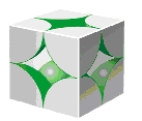
A) face centered cubic, 4 atoms
B) primitive cubic, 1 atom
C) body centered cubic, 2 atoms
D) face centered cubic, 13 atoms
E) primitive cubic, 7 atoms

A) face centered cubic, 4 atoms
B) primitive cubic, 1 atom
C) body centered cubic, 2 atoms
D) face centered cubic, 13 atoms
E) primitive cubic, 7 atoms

Unlock Deck
Unlock for access to all 67 flashcards in this deck.
Unlock Deck
k this deck
18
Chromium (atomic mass 52.00 g/mol) crystallizes in a body-centered cubic unit cell. If the length of an edge of the unit cell is 289 pm, what is the density (in g/cm3) of chromium?
A) 3.58 g/cm3
B) 7.15 g/cm3
C) 13.7 g/cm3
D) 14.3 g/cm3
E) 21.3 g/cm3
A) 3.58 g/cm3
B) 7.15 g/cm3
C) 13.7 g/cm3
D) 14.3 g/cm3
E) 21.3 g/cm3

Unlock Deck
Unlock for access to all 67 flashcards in this deck.
Unlock Deck
k this deck
19
Nickel has a face-centered cubic cell, and its density is 8.90 g/cm3. What is the radius (in pm) of a nickel atom? (The molar mass of nickel is 58.69 g/mol)
A) 62.3 pm
B) 88.1 pm
C) 125 pm
D) 249 pm
E) 535 pm
A) 62.3 pm
B) 88.1 pm
C) 125 pm
D) 249 pm
E) 535 pm

Unlock Deck
Unlock for access to all 67 flashcards in this deck.
Unlock Deck
k this deck
20
Polonium (atomic mass 209.0 g/mol) crystallizes in a primitive cubic unit cell. If the density of polonium is 9.15 g/cm3, what is the radius of a polonium atom (in pm)?
A) 168 pm
B) 238 pm
C) 336 pm
D) 475 pm
E) 672 pm
A) 168 pm
B) 238 pm
C) 336 pm
D) 475 pm
E) 672 pm

Unlock Deck
Unlock for access to all 67 flashcards in this deck.
Unlock Deck
k this deck
21
If an ionic solid has a face-centered cubic lattice of anions (Xn−) and all the octahedral holes are occupied by metal cations (Mm+), what is the formula for the compound?
A) M2X
B) MX
C) MX2
D) M2X3
E) M3X2
A) M2X
B) MX
C) MX2
D) M2X3
E) M3X2

Unlock Deck
Unlock for access to all 67 flashcards in this deck.
Unlock Deck
k this deck
22
Strontium oxide has a face centered cubic unit cell of oxide ions with the strontium ions in octahedral holes. If the radius of Sr2+ is 127 pm and the radius of O2- is 135 pm, what is the density of strontium ions oxide? (100 cm = 1 × 1012 pm)
A) 0.209 g/cm3
B) 1.20 g/cm3
C) 2.39 g/cm3
D) 4 g/cm3
E) 4.78 g/cm3
A) 0.209 g/cm3
B) 1.20 g/cm3
C) 2.39 g/cm3
D) 4 g/cm3
E) 4.78 g/cm3

Unlock Deck
Unlock for access to all 67 flashcards in this deck.
Unlock Deck
k this deck
23
What is the simplest formula of the compound represented by the unit cell provided below? 
A) AB
B) AB2
C) AB3
D) A2B3
E) A2B4

A) AB
B) AB2
C) AB3
D) A2B3
E) A2B4

Unlock Deck
Unlock for access to all 67 flashcards in this deck.
Unlock Deck
k this deck
24
Iron(II) sulfide has a primitive cubic unit cell with sulfide ions at the lattice points. The ionic radii of iron(II) ions and sulfide ions are 88 pm and 184 pm, respectively. What is the density of FeS (in g/cm3)?
A) 2.56 g/cm3
B) 4.71 g/cm3
C) 5.25 g/cm3
D) 6.66 g/cm3
E) 8.97 g/cm3
A) 2.56 g/cm3
B) 4.71 g/cm3
C) 5.25 g/cm3
D) 6.66 g/cm3
E) 8.97 g/cm3

Unlock Deck
Unlock for access to all 67 flashcards in this deck.
Unlock Deck
k this deck
25
The metal sodium crystallizes in a body-centered cubic lattice. If the density of sodium is 0.968 g/cm3, what is the unit cell edge length?
A) 429 pm
B) 51.9 pm
C) 151 pm
D) 41.2 pm
E) 340 pm
A) 429 pm
B) 51.9 pm
C) 151 pm
D) 41.2 pm
E) 340 pm

Unlock Deck
Unlock for access to all 67 flashcards in this deck.
Unlock Deck
k this deck
26
Which of the following compounds is expected to have the strongest ionic bonds?
A) MgO
B) KBr
C) NaI
D) BaO
E) SrS
A) MgO
B) KBr
C) NaI
D) BaO
E) SrS

Unlock Deck
Unlock for access to all 67 flashcards in this deck.
Unlock Deck
k this deck
27
Silver chloride adopts the sodium chloride (rock salt) structure. The length of a unit cell edge is 555 pm. What is the density of AgCl?
A) 5.57 g/cm3
B) 4.19 g/cm3
C) 2.79 g/cm3
D) 2.10 g/cm3
E) 1.39 g/cm3
A) 5.57 g/cm3
B) 4.19 g/cm3
C) 2.79 g/cm3
D) 2.10 g/cm3
E) 1.39 g/cm3

Unlock Deck
Unlock for access to all 67 flashcards in this deck.
Unlock Deck
k this deck
28
If an ionic compound with the formula MX2 forms a face-centered cubic unit cell with the cations (M2n+) at the lattice points, the anions (Xn-) will occupy:
A) all of the tetrahedral holes in each unit cell.
B) half of the tetrahedral holes in each unit cell.
C) all of the octahedral holes in each unit cell.
D) the center of each face in each unit cell.
E) the cubic hole in the center of each unit cell.
A) all of the tetrahedral holes in each unit cell.
B) half of the tetrahedral holes in each unit cell.
C) all of the octahedral holes in each unit cell.
D) the center of each face in each unit cell.
E) the cubic hole in the center of each unit cell.

Unlock Deck
Unlock for access to all 67 flashcards in this deck.
Unlock Deck
k this deck
29
Which of the following is expected to have the most negative lattice enthalpy?
A) LiCl
B) NaCl
C) KCl
D) RbCl
E) CsCl
A) LiCl
B) NaCl
C) KCl
D) RbCl
E) CsCl

Unlock Deck
Unlock for access to all 67 flashcards in this deck.
Unlock Deck
k this deck
30
Strontium oxide has a face-centered cubic unit cell of oxide ions with the strontium in octahedral holes. If the radius of Sr2+ is 127 pm and the density of SrO is 4.7 g/cm3, what is the radius of the oxide ion? (100 cm = 1 × 1012 pm)
A) 176 pm
B) 132 pm
C) 127 pm
D) 137 pm
E) 273 pm
A) 176 pm
B) 132 pm
C) 127 pm
D) 137 pm
E) 273 pm

Unlock Deck
Unlock for access to all 67 flashcards in this deck.
Unlock Deck
k this deck
31
Calcium sulfide has a face-centered cubic unit cell with calcium ions in octahedral holes. How many ions of each element are contained in each unit cell?
A) 1 calcium ion; 1 sulfide ion
B) 2 calcium ions; 2 sulfide ions
C) 2 calcium ions; 4 sulfide ions
D) 4 calcium ions; 2 sulfide ions
E) 4 calcium ions; 4 sulfide ions
A) 1 calcium ion; 1 sulfide ion
B) 2 calcium ions; 2 sulfide ions
C) 2 calcium ions; 4 sulfide ions
D) 4 calcium ions; 2 sulfide ions
E) 4 calcium ions; 4 sulfide ions

Unlock Deck
Unlock for access to all 67 flashcards in this deck.
Unlock Deck
k this deck
32
Nickel crystallizes in a face-centered cubic lattice. The density of the nickel is 8.91 g/cm3. What is the volume of a single unit cell?
A) cm3
B) cm3
C) ?? cm3
D) cm3
E) ?? cm3
A) cm3
B) cm3
C) ?? cm3
D) cm3
E) ?? cm3

Unlock Deck
Unlock for access to all 67 flashcards in this deck.
Unlock Deck
k this deck
33
If an ionic compound with the formula MX forms a primitive cubic unit cell with the anions (Xn-) at the lattice points, the cations (M2n+) will occupy:
A) all of the tetrahedral holes in each unit cell.
B) half of the tetrahedral holes in each unit cell.
C) the cubic hole in the center of each unit cell.
D) the center of each face in each unit cell.
E) all of the octahedral holes in each unit cell.
A) all of the tetrahedral holes in each unit cell.
B) half of the tetrahedral holes in each unit cell.
C) the cubic hole in the center of each unit cell.
D) the center of each face in each unit cell.
E) all of the octahedral holes in each unit cell.

Unlock Deck
Unlock for access to all 67 flashcards in this deck.
Unlock Deck
k this deck
34
Cesium bromide crystallizes in a primitive cubic unit cell with bromide ions at the lattice points. The cesium ions occupy cubic holes. How many bromide ions surround each cesium ion in cesium bromide?
A) 1
B) 2
C) 4
D) 8
E) 12
A) 1
B) 2
C) 4
D) 8
E) 12

Unlock Deck
Unlock for access to all 67 flashcards in this deck.
Unlock Deck
k this deck
35
In what type of unit cell are the "A" atoms arranged in the given unit cell? 2 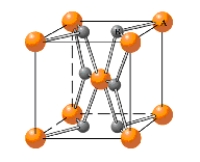
A) primitive cubic
B) body-centered cubic
C) face-centered cubic

A) primitive cubic
B) body-centered cubic
C) face-centered cubic

Unlock Deck
Unlock for access to all 67 flashcards in this deck.
Unlock Deck
k this deck
36
Lithium chloride crystallizes in a face-centered cubic unit cell with chloride ions occupying the lattice points and lithium ions occupying octahedral holes. How many chloride ions surround each lithium ion in LiCl?
A) 1
B) 4
C) 6
D) 8
E) 12
A) 1
B) 4
C) 6
D) 8
E) 12

Unlock Deck
Unlock for access to all 67 flashcards in this deck.
Unlock Deck
k this deck
37
A metal crystallizes in a face-centered cubic lattice. The radius of the atom is 214 pm and the density of the element is 2.63 g/cm3. What is the identity of the metal?
A) Ni
B) Yb
C) Cu
D) Ca
E) Sr
A) Ni
B) Yb
C) Cu
D) Ca
E) Sr

Unlock Deck
Unlock for access to all 67 flashcards in this deck.
Unlock Deck
k this deck
38
Magnesium sulfide (molar mass 56.37 g/mol) has a face-centered cubic unit cell with magnesium ions in octahedral holes. The ionic radii of magnesium ions and sulfide ions are 79 pm and 184 pm, respectively. What is the density of MgS (in g/cm3)?
A) 1.29 g/cm3
B) 2.57 g/cm3
C) 3.64 g/cm3
D) 5.15 g/cm3
E) 7.28 g/cm3
A) 1.29 g/cm3
B) 2.57 g/cm3
C) 3.64 g/cm3
D) 5.15 g/cm3
E) 7.28 g/cm3

Unlock Deck
Unlock for access to all 67 flashcards in this deck.
Unlock Deck
k this deck
39
Rubidium iodide (molar mass 212.4 g/mol) has a face-centered cubic unit cell with rubidium ions in octahedral holes. If the radius of iodide ion is 219 pm and the density of RbI is 3.55 g/cm3, what is the radius of the rubidium ion (in pm)?
A) 112 pm
B) 149 pm
C) 181 pm
D) 297 pm
E) 419 pm
A) 112 pm
B) 149 pm
C) 181 pm
D) 297 pm
E) 419 pm

Unlock Deck
Unlock for access to all 67 flashcards in this deck.
Unlock Deck
k this deck
40
Which of the following compounds is expected to have the strongest ionic bonds?
A) RbI
B) KCl
C) NaBr
D) CsF
E) LiF
A) RbI
B) KCl
C) NaBr
D) CsF
E) LiF

Unlock Deck
Unlock for access to all 67 flashcards in this deck.
Unlock Deck
k this deck
41
The lattice energy of NaCl(s) is -786 kJmol. Use this value and the following thermochemical data to determine the electron attachment enthalpy of Cl(g). ?IE is the enthalpy of ionization.
A) -1921 kJ/mol
B) -473 kJ/mol
C) -349 kJ/mol
D) +349 kJ/mol
E) +473 kJ/mol
A) -1921 kJ/mol
B) -473 kJ/mol
C) -349 kJ/mol
D) +349 kJ/mol
E) +473 kJ/mol

Unlock Deck
Unlock for access to all 67 flashcards in this deck.
Unlock Deck
k this deck
42
The bandgap of ZnTe is 218 kJ/mol. What is the maximum wavelength of light that can excite an electron transition across the band gap? (h = 6.626 × 10-34 J·s; c = 3.000 × 108 m/s)
A) 551 nm
B) 549.0 nm
C) 7298 nm
D) 873.7 nm
E) 517 nm
A) 551 nm
B) 549.0 nm
C) 7298 nm
D) 873.7 nm
E) 517 nm

Unlock Deck
Unlock for access to all 67 flashcards in this deck.
Unlock Deck
k this deck
43
Which two of the following materials are most likely to be amorphous solids: ice, nylon, glass, potassium nitrate?
A) water and glass
B) nylon and aspirin
C) water and nylon
D) water and aspirin
E) nylon and glass
A) water and glass
B) nylon and aspirin
C) water and nylon
D) water and aspirin
E) nylon and glass

Unlock Deck
Unlock for access to all 67 flashcards in this deck.
Unlock Deck
k this deck
44
In metals, there are not enough electrons to fill all of the electronic energy levels. At 0 K, the highest energy level filled is referred to as the ________.
A) valence band
B) conduction band
C) triple point
D) Fermi level
E) band gap
A) valence band
B) conduction band
C) triple point
D) Fermi level
E) band gap

Unlock Deck
Unlock for access to all 67 flashcards in this deck.
Unlock Deck
k this deck
45
Using the following data to calculate the lattice energy of NaBr(s). ?IE and ?EA are enthalpy of ionization and electron attachment enthalpy, respectively.
A) -1401 kJ
B) -751 kJ
C) -241 kJ
D) +241 kJ
E) +751 kJ
A) -1401 kJ
B) -751 kJ
C) -241 kJ
D) +241 kJ
E) +751 kJ

Unlock Deck
Unlock for access to all 67 flashcards in this deck.
Unlock Deck
k this deck
46
An unknown white solid was found to have a melting point of 150oC. It is soluble in water, but it is a poor conductor of electricity in an aqueous solution. The white solid most likely is _____.
A) C6H12O6 (glucose)
B) KCl
C) Rb
D) C (diamond)
E) Si
A) C6H12O6 (glucose)
B) KCl
C) Rb
D) C (diamond)
E) Si

Unlock Deck
Unlock for access to all 67 flashcards in this deck.
Unlock Deck
k this deck
47
A low-melting solid readily dissolves in water to produce a nonconducting solution. The solid is most likely a(n) _____.
A) molecular solid
B) ionic solid
C) covalent network solid
D) weak base
E) metallic solid
A) molecular solid
B) ionic solid
C) covalent network solid
D) weak base
E) metallic solid

Unlock Deck
Unlock for access to all 67 flashcards in this deck.
Unlock Deck
k this deck
48
Which one of the following substances is incorrectly matched with the kind of solid it forms? Substance/Kind of Solid
A) sulfur dioxide/molecular
B) graphite/covalent
C) calcium bromide/ionic
D) iron/ionic
E) methane/molecular
A) sulfur dioxide/molecular
B) graphite/covalent
C) calcium bromide/ionic
D) iron/ionic
E) methane/molecular

Unlock Deck
Unlock for access to all 67 flashcards in this deck.
Unlock Deck
k this deck
49
Which of the following elements might be used as a dopant in a silicon host to create a p-type semiconductor?
A) Al
B) P
C) As
D) S
E) Ge
A) Al
B) P
C) As
D) S
E) Ge

Unlock Deck
Unlock for access to all 67 flashcards in this deck.
Unlock Deck
k this deck
50
Elements that have their highest energy electrons in a filled band of molecular orbitals, separated from the lowest empty band by an energy difference much too large for electrons to jump between bands, are called _____.
A) semiconductors
B) metals
C) conductors
D) insulators
E) isomorphs
A) semiconductors
B) metals
C) conductors
D) insulators
E) isomorphs

Unlock Deck
Unlock for access to all 67 flashcards in this deck.
Unlock Deck
k this deck
51
According to the below phase diagram, what process occurs if a pure substance begins at point C and the pressure on the substance is increased until point B is reached? 
A) Fusion
B) Vaporization
C) Condensation
D) Sublimation
E) None of these

A) Fusion
B) Vaporization
C) Condensation
D) Sublimation
E) None of these

Unlock Deck
Unlock for access to all 67 flashcards in this deck.
Unlock Deck
k this deck
52
What process occurs when the temperature of a substance at Point A is increased (at constant pressure) until the substance is at Point B? 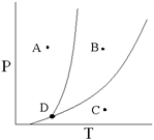
A) Condensation
B) Vaporization
C) Sublimation
D) Melting
E) Freezing

A) Condensation
B) Vaporization
C) Sublimation
D) Melting
E) Freezing

Unlock Deck
Unlock for access to all 67 flashcards in this deck.
Unlock Deck
k this deck
53
Lattice enthalpy may be calculated from thermodynamic data using _____.
A) the Clausius-Clapeyron equation
B) the Born-Haber cycle
C) the dynamic equilibrium expression
D) Avogadro's hypothesis
E) cubic cell enthalpy of formation equation
A) the Clausius-Clapeyron equation
B) the Born-Haber cycle
C) the dynamic equilibrium expression
D) Avogadro's hypothesis
E) cubic cell enthalpy of formation equation

Unlock Deck
Unlock for access to all 67 flashcards in this deck.
Unlock Deck
k this deck
54
Using the thermodynamic data below and a value of -717 kJ/mole for the lattice enthalpy for KCl, calculate the ionization energy of K.
A) -576 kJ/mol
B) +141 kJ/mol
C) +419 kJ/mol
D) +576 kJ/mol
E) +597 kJ/mol
A) -576 kJ/mol
B) +141 kJ/mol
C) +419 kJ/mol
D) +576 kJ/mol
E) +597 kJ/mol

Unlock Deck
Unlock for access to all 67 flashcards in this deck.
Unlock Deck
k this deck
55
Point D on the phase diagram is referred to as the _____ point. 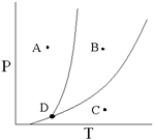
A) triple
B) normal boiling
C) critical
D) normal freezing
E) divergent

A) triple
B) normal boiling
C) critical
D) normal freezing
E) divergent

Unlock Deck
Unlock for access to all 67 flashcards in this deck.
Unlock Deck
k this deck
56
On the phase diagram below, which point corresponds to conditions where only the gas phase exists? 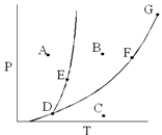
A) A
B) B
C) C
D) D
E) G

A) A
B) B
C) C
D) D
E) G

Unlock Deck
Unlock for access to all 67 flashcards in this deck.
Unlock Deck
k this deck
57
The lattice energy of NaBr is -752 kJ/mol. This energy corresponds to which of the following reactions?
A) Na(s) + 1/2 Br2(g) → NaBr(s)
B) Na(g) + Br(g) → NaBr(s)..
C) Na(g) + Br(g) → NaBr(s)
D) Na+(g) + Br-(g) → NaBr(s)
E) Na+(aq) + Br-(aq) → NaBr(s).
A) Na(s) + 1/2 Br2(g) → NaBr(s)
B) Na(g) + Br(g) → NaBr(s)..
C) Na(g) + Br(g) → NaBr(s)
D) Na+(g) + Br-(g) → NaBr(s)
E) Na+(aq) + Br-(aq) → NaBr(s).

Unlock Deck
Unlock for access to all 67 flashcards in this deck.
Unlock Deck
k this deck
58
Which one of the following elements is a semiconductor?
A) Li
B) Fe
C) Cl
D) Ni
E) Si
A) Li
B) Fe
C) Cl
D) Ni
E) Si

Unlock Deck
Unlock for access to all 67 flashcards in this deck.
Unlock Deck
k this deck
59
Which process requires the greatest endothermic change in enthalpy for water?
A) Freezing
B) Condensation
C) Sublimation
D) Melting
E) Vaporization
A) Freezing
B) Condensation
C) Sublimation
D) Melting
E) Vaporization

Unlock Deck
Unlock for access to all 67 flashcards in this deck.
Unlock Deck
k this deck
60
Which of the following ionic compounds is expected to have the lowest enthalpy of fusion?
A) NaI
B) NaCl
C) NaBr
D) NaF
E) None of these
A) NaI
B) NaCl
C) NaBr
D) NaF
E) None of these

Unlock Deck
Unlock for access to all 67 flashcards in this deck.
Unlock Deck
k this deck
61
The energy of formation of one mole of solid crystalline ionic compound when ions in the gas phase combine is referred to as _____.
A) lattice energy
B) degenerate energy
C) ionization energy
D) dissociation energy
E) elastic energy
A) lattice energy
B) degenerate energy
C) ionization energy
D) dissociation energy
E) elastic energy

Unlock Deck
Unlock for access to all 67 flashcards in this deck.
Unlock Deck
k this deck
62
Given the accompanying phase diagram, under what conditions will liquid be found in equilibrium with either solid or gas? 
A) Anywhere along curve AB
B) Anywhere along curve AC
C) Anywhere along curve AD
D) Anywhere along curve AB and AC
E) Anywhere along curve AB and AD

A) Anywhere along curve AB
B) Anywhere along curve AC
C) Anywhere along curve AD
D) Anywhere along curve AB and AC
E) Anywhere along curve AB and AD

Unlock Deck
Unlock for access to all 67 flashcards in this deck.
Unlock Deck
k this deck
63
Which of the following statements is true about semiconductors?
A) Pure silicon and germanium are called intrinsic semiconductors.
B) In extrinsic semiconductors, the number of electrons in the conduction band is determined by the temperature and the magnitude of the band gap.
C) Dopants are present in intrinsic semiconductors.
D) The conductivity of intrinsic semiconductors is controlled by adding small numbers of different atoms.
E) The types of intrinsic semiconductors include p-type and n-type semiconductors.
A) Pure silicon and germanium are called intrinsic semiconductors.
B) In extrinsic semiconductors, the number of electrons in the conduction band is determined by the temperature and the magnitude of the band gap.
C) Dopants are present in intrinsic semiconductors.
D) The conductivity of intrinsic semiconductors is controlled by adding small numbers of different atoms.
E) The types of intrinsic semiconductors include p-type and n-type semiconductors.

Unlock Deck
Unlock for access to all 67 flashcards in this deck.
Unlock Deck
k this deck
64
A sketch of a phase diagram is given below. 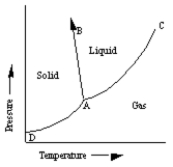 Which statement about this diagram is not true?
Which statement about this diagram is not true?
A) Increasing pressure at constant temperature can melt the solid.
B) Increasing temperature at constant pressure can cause the solid to sublime.
C) Increasing temperature at constant pressure can cause the liquid to vaporize.
D) Increasing pressure at constant temperature can cause deposition of solid from gas.
E) Increasing pressure at constant temperature can cause liquid to freeze.
 Which statement about this diagram is not true?
Which statement about this diagram is not true?A) Increasing pressure at constant temperature can melt the solid.
B) Increasing temperature at constant pressure can cause the solid to sublime.
C) Increasing temperature at constant pressure can cause the liquid to vaporize.
D) Increasing pressure at constant temperature can cause deposition of solid from gas.
E) Increasing pressure at constant temperature can cause liquid to freeze.

Unlock Deck
Unlock for access to all 67 flashcards in this deck.
Unlock Deck
k this deck
65
Above a substance's _____ temperature, it is not possible to compress the substance into the liquid phase. If enough pressure is applied the substance will become a supercritical fluid.

Unlock Deck
Unlock for access to all 67 flashcards in this deck.
Unlock Deck
k this deck
66
A salt with a 1:1 ratio of anions to cations may pack in a face-centered cubic unit cell with the anions at the lattice points and the cations occupying one-half of the _____ holes. Zinc sulfide is an example of this structure.

Unlock Deck
Unlock for access to all 67 flashcards in this deck.
Unlock Deck
k this deck
67
Sodium chloride crystallizes in a(n) _____ cubic unit cell with chloride ions occupying the lattice points. The sodium ions occupy interstitial regions, with each cation in contact with six chloride ions.

Unlock Deck
Unlock for access to all 67 flashcards in this deck.
Unlock Deck
k this deck



